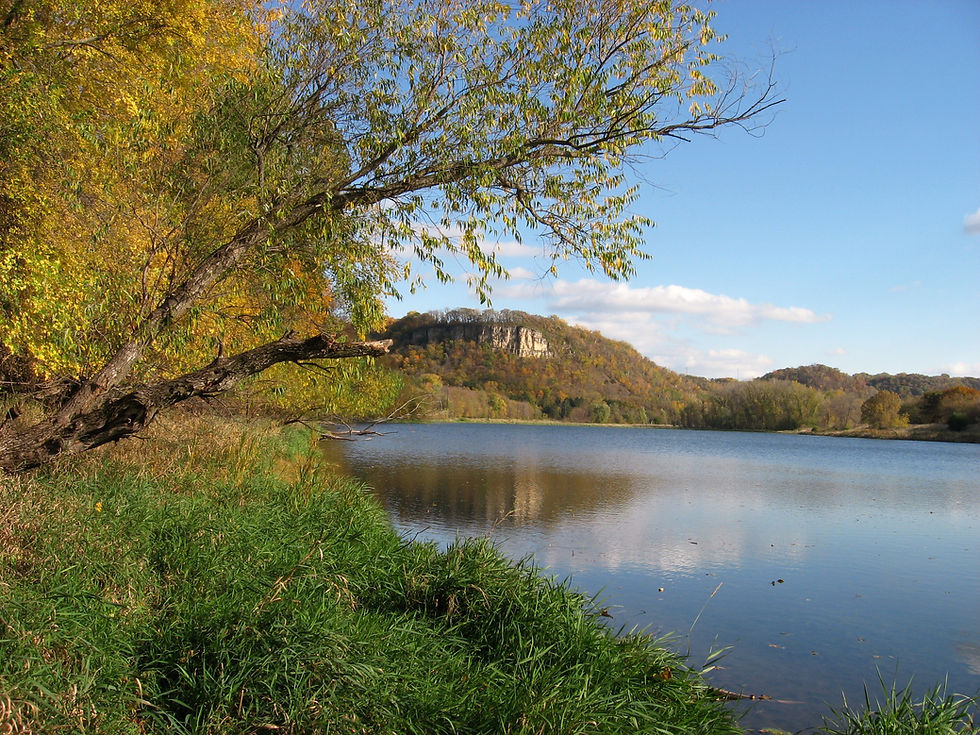State Park Expands
- wacoutanaturenotes
- May 19, 2020
- 3 min read

State Park
You may have noticed on May 13th, a new sign appeared along Wacouta Road. The previous sign indicated Wacouta Pond was a dedicated DNR Wildlife Management Area.
It was established 40 plus years ago as the north unit of the Perched Valley Wildlife Management Area. Due to a recent land transfer of 127 acres within the DNR, Wacouta Pond is now part of Frontenac State Park. For the most part, land use will remain the same including restrictions on hunting and the use of motorized vehicles.

Wacouta Pond
Prior to the land transfer, the western boundary for Frontenac State Park was the crest of Rattlesnake Bluff. The new boundary is now Wacouta Road. This photo of the pond and surrounding spring foliage was taken on Saturday May 16th.

Wacouta Prairie Waiting For Green-Up
With 3.6 inches of rain on Sunday May 17th, it won't be long before the exciting Wacouta prairie project will spring forth with new growth.

Nesting Bluebird
For several years, we have struggled with nesting success in our bluebird nest boxes. It seemed as though if a pair of bluebirds started to build a nest, they were always driven away by house sparrows or wrens.
This spring with assistance from our neighbors Dave and Suzette McDougal our efforts were successful. Dave designed and constructed an unique nesting box. Suzette provided expertise on increasing the odds for success. First, get the bird's attention by providing a treat of meal worms a couple times a day.
Once the nest is built and a couple eggs appear, suspend a strip of flashy mylar near the entrance. This will do a wonderful job of deterring invading birds. This female bluebird is currently incubating 6 eggs.

Barred Owl
On a recent spring wildflower outing in the local area, Kathy and I encountered this cooperative barred owl. These owls are common is our area and have a distinctive call with a rhythmic series of loud hoots: "who-cooks- for-you, who-cooks=for-you-all."
These owls are easily flushed and I have had very few opportunities to photograph them previously.

Adult Sandhill Crane
This spring we have heard the distinctive trumpeting call and on occasion observed sandhill cranes flying over our house. They seem to be travelling between the wetland area south of Highway 61 to Wacouta Bay and back. I have never observed them on the bay. That is until my canoe outing on the evening of May 14th.

Pair of Cranes
As I was approaching the mouth of Bullard's Creek, a pair of cranes circled overhead and promptly landed in a flock of about 50 Canada geese. At that point I was about 150 yards away. Much too far for photos with my camera.
I was apprehensive about paddling any closer for fear of spooking the geese and then the cranes. With nothing to lose, I eventually paddled closer. This did chase the geese away, but the cranes were not concerned and stayed put.

Preening Crane
I continued paddling to within 50 yards of these birds. What happened next was very surprising. They started walking directly towards me and stopped at a distance of no more that 20 yards.
Sandhill cranes preen themselves by rubbing mud on their feathers. In our north country, there is an abundance of iron in the soil and water which stains the feathers. As the summer goes by, the rusty red color eventually wears away and the bird's color returns to it's more normal gray.

Adult and Juvenile Cranes
This photo was taken in the early fall of 2010. As you can see, the gray color of the juvenile is their normal color. I assumed they were eating spilled grain or maybe picking up grit along the tracks. I found it interesting they were sharing responsibility for keeping attentive to oncoming traffic! Or maybe it was simply coincidence.




So glad I was finally able to open this one!